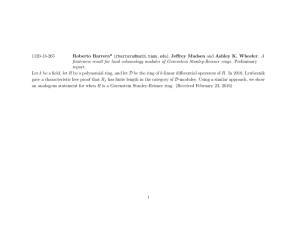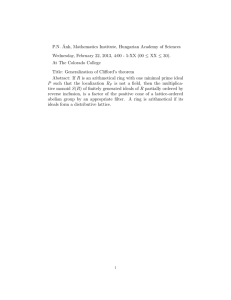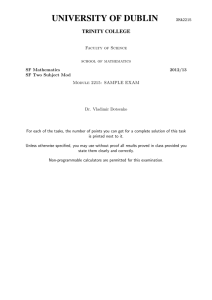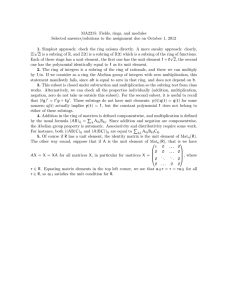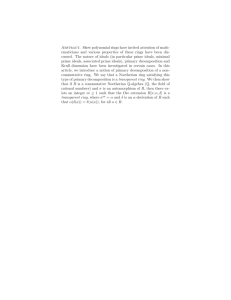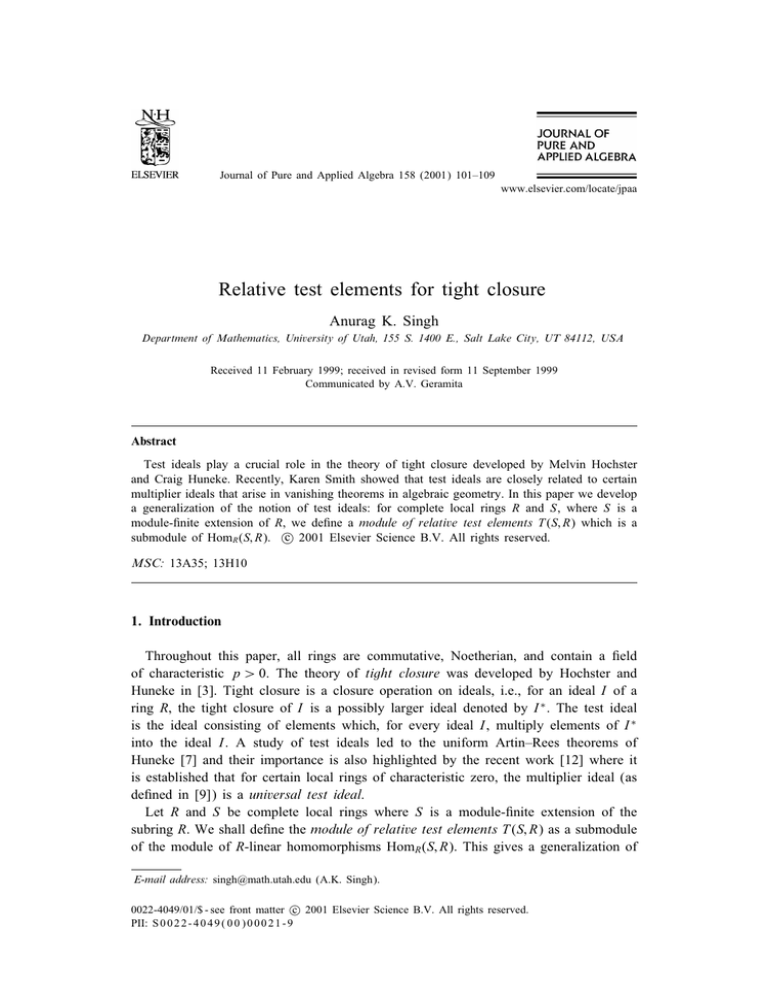
Journal of Pure and Applied Algebra 158 (2001) 101–109
www.elsevier.com/locate/jpaa
Relative test elements for tight closure
Anurag K. Singh
Department of Mathematics, University of Utah, 155 S. 1400 E., Salt Lake City, UT 84112, USA
Received 11 February 1999; received in revised form 11 September 1999
Communicated by A.V. Geramita
Abstract
Test ideals play a crucial role in the theory of tight closure developed by Melvin Hochster
and Craig Huneke. Recently, Karen Smith showed that test ideals are closely related to certain
multiplier ideals that arise in vanishing theorems in algebraic geometry. In this paper we develop
a generalization of the notion of test ideals: for complete local rings R and S, where S is a
module-6nite extension of R, we de6ne a module of relative test elements T (S; R) which is a
c 2001 Elsevier Science B.V. All rights reserved.
submodule of HomR (S; R). MSC: 13A35; 13H10
1. Introduction
Throughout this paper, all rings are commutative, Noetherian, and contain a 6eld
of characteristic p ¿ 0. The theory of tight closure was developed by Hochster and
Huneke in [3]. Tight closure is a closure operation on ideals, i.e., for an ideal I of a
ring R, the tight closure of I is a possibly larger ideal denoted by I ∗ . The test ideal
is the ideal consisting of elements which, for every ideal I , multiply elements of I ∗
into the ideal I . A study of test ideals led to the uniform Artin–Rees theorems of
Huneke [7] and their importance is also highlighted by the recent work [12] where it
is established that for certain local rings of characteristic zero, the multiplier ideal (as
de6ned in [9]) is a universal test ideal.
Let R and S be complete local rings where S is a module-6nite extension of the
subring R. We shall de6ne the module of relative test elements T (S; R) as a submodule
of the module of R-linear homomorphisms HomR (S; R). This gives a generalization of
E-mail address: singh@math.utah.edu (A.K. Singh).
c 2001 Elsevier Science B.V. All rights reserved.
0022-4049/01/$ - see front matter PII: S 0 0 2 2 - 4 0 4 9 ( 0 0 ) 0 0 0 2 1 - 9
102
A.K. Singh / Journal of Pure and Applied Algebra 158 (2001) 101–109
test ideals in the following sense: for a complete local ring S, the module T (S; S)
is isomorphic to the test ideal of S. While we do not pursue it here the theory can
also be developed when R and S are N-graded rings over a perfect (or F-6nite) 6eld
R0 = S0 = K.
If the subring R of S is Gorenstein, then HomR (S; R) ∼
= !S , the canonical module of S,
and T (S; R) may be viewed as a submodule of !S . We show that T (S; R) does not depend on a speci6c choice of the Gorenstein subring R and is, in fact, the parameter test
module de6ned in [11]. This is an F-submodule of !S in the terminology of Smith [11],
and consequently has suitable localization properties.
2. Notation and denitions
Let R be a Noetherian ring of characteristic p ¿ 0. The letter e denotes a variable
nonnegative integer, and q its eth power, q=pe . A reduced ring R, is said to be F-2nite
if R1=p , the ring obtained by adjoining all p th roots of elements of R, is module-6nite
over R. A 6nitely generated algebra R over a 6eld K is F-6nite precisely when K 1=p
is a 6nite 6eld extension of K.
◦
We shall denote by R the complement of the union of the minimal primes of R. An
ideal I =(x1 ; : : : ; x n ) ⊆ R is said to be a parameter ideal if the images of x1 ; : : : ; x n form
part of a system of parameters in the local ring RP for every prime ideal P containing I .
We shall denote by F the Frobenius endomorphism of R and by F e , its eth iteration.
For an ideal I =(x1 ; : : : ; x n ) ⊆ R, we use I [q] to denote F e (I )R=(x1q ; : : : ; xqn ) where q=pe .
For an R-module M , the R-module structure of F e (M ) is given by r (r ⊗ m) = r r ⊗ m,
and r ⊗ rm = r r q ⊗ m. For R-modules N ⊆ M , we use NM[q] to denote Im(F e (N ) →
◦
F e (M )). We say that u ∈ NM∗ , the tight closure of N in M , if there exists c ∈ R
such that cuq ∈ NM[q] for all q = pe 0. If NM∗ = N we say that N is a tightly closed
submodule of M .
It is worth recording the case when M = R and N = I is an ideal of R. For an
◦
element x of R, we say that x ∈ I ∗ if there exists c ∈ R such that cxq ∈ I [q] for all
q = pe 0.
For R-modules N ⊆ M we de6ne NM∗fg , the 2nitistic tight closure of N in M , as
the union of the modules (M ∩ N )∗M where the union is taken over all the 6nitely
generated submodules M of M .
A ring R is weakly F-regular if every ideal of R is tightly closed, and is F-regular if
every localization is weakly F-regular. An F-rational ring is one in which all parameter
ideal are tightly closed.
The test ideal of the ring R is de6ned as
R =
AnnR 0∗M ;
M
where M runs through all 6nitely generated R-modules. If a local ring (R; m) is approximately Gorenstein, i.e., has a sequence of m-primary irreducible ideals {It } co6nal
A.K. Singh / Journal of Pure and Applied Algebra 158 (2001) 101–109
103
with the powers of m, then
R = (It : It∗ ):
t
It should be mentioned that an excellent reduced ring is approximately Gorenstein.
◦
We say that an element c ∈ R is a test element if for all ideals I of R, we have
cI ∗ ⊆ I .
It is not known if the test ideal commutes with localization and completion in general,
but several strong positive results are now available: in [10] Smith showed that if R is
a complete local Gorenstein ring with test ideal , then the test ideal of a localization
RP is RP . In [2] Aberbach and MacCrimmon showed that the same result is true if
R is a reduced Q-Gorenstein local ring. More recently, Lyubeznik and Smith proved
that if a ring R is Cohen-Macaulay with only isolated non-Gorenstein points, or if it
has only isolated singularities, or if it is N-graded over a 6eld, then test elements of
R continue to be test elements after localization and completion, see [8].
Our references for the theory of tight closure are [3–6]. We next record some well
known facts about local cohomology and canonical modules.
Let (R; m; K) be a local ring of dimension with a system of parameters x1 ; : : : ; xd .
The local cohomology module Hmd (R) of R may be identi6ed with
lim
R
;
−→ (x t ; : : : ; x t )R
1
d
where the maps in the direct are induced by multiplication by the element x1 · · · xd .
Let ER = ER (K) denote the injective hull of the residue 6eld K as an R-module. If R
is a complete local ring, then we may de6ne the canonical module of R to be
!R = HomR (Hmd (R); ER )
and we then have
HomR (!R ; ER ) ∼
= Hmd (R):
If, in addition, R is normal then Hmd (!R ) ∼
= ER .
For a local inclusion (R; m; K) ,→ (S; n; L) where S is module-6nite over the subring
R, the module HomR (S; !R ) is isomorphic to the canonical module of the ring S.
3. The module of relative test elements
Throughout this paper (R; m; K) and (S; n; L) will be complete local rings where S
is module-6nite over the subring R. We shall also assume that these rings are reduced
and F-6nite. In this setting we shall de6ne the module of relative test elements as a
submodule of HomR (S; R), the S-module consisting of R-linear homomorphism from S
to the ring R.
Let ER denote the injective hull of the residue 6eld K as an R-module. Then ES =
HomR (S; ER ) is the injective hull of L as an S-module. The following isomorphisms
104
A.K. Singh / Journal of Pure and Applied Algebra 158 (2001) 101–109
are easily veri6ed:
HomS (ER ⊗R S; HomR (S; ER )) ∼
= HomR (ER ⊗R S ⊗S S; ER )
∼
= HomR (ER ⊗R S; ER )
∼
= HomR (S; HomR (ER ; ER ))
∼
= HomR (S; R):
Under these isomorphism, a map ! ∈ HomR (S; R) corresponds to the map !˜ ∈
HomS (ER ⊗R S; HomR (S; ER )) where, for elements s and s ∈ S and e ∈ ER , we have
˜ ⊗ s))(s ) = !(ss )e ∈ ER :
(!(e
Consider the inclusion
0∗fg
ER ⊗R S ⊆ ER ⊗R S;
where 0∗fg
ER ⊗R S denotes the 6nitistic tight closure of the zero submodule of the S-module,
ER ⊗R S. Applying the functor ∨ = HomS ( ; ES ), we get a surjection
∨
HomR (S; R) (0∗fg
ER ⊗R S ) :
and the module of relative test elements T (S; R) is de6ned as the kernel of this surjection:
˜ ∗fg ) = 0}:
T (S; R) = {! ∈ HomR (S; R): !(0
ER ⊗R S
Proposition 1. For complete local reduced rings R and S where S is module-2nite
over the subring R; the following are equivalent characterizations of the module of
relative test elements:
˜ ∗fg ) = 0};
(1) T (S; R) = {! ∈ HomR (S; R): !(0
ER ⊗R S
(2) T (S; R) = {! ∈ HomR (S; R): !((IS)∗ ) ⊆ I for all ideals I ⊆ R}; and
(3) T (S; R) = {! ∈ HomR (S; R): !((It S)∗ ) ⊆ It where {It } is a sequence of m-primary
irreducible ideals of R co2nal with the powers of m.
Proof. Since R is an excellent reduced ring, it is approximately Gorenstein, and there
exists a sequence {It } of m-primary irreducible ideals co6nal with the powers of the
maximal ideal. Since R=It ∼
= AnnER (It ), we may write ER = lim R=It . Note that
−→
˜ mod It ))(s ) = !(ss ) mod It :
(!(s
˜ ∗fg ) = 0 is therefore equivalent to the condition that !((It S)∗ ) ⊆ It
The condition !(0
ER ⊗R S
for all t ≥ 1. It remains to show that this implies !((IS)∗ ) ⊆ I for all ideals I ⊆ R.
Let ! ∈ HomR (S; R) be a homomorphism which satis6es !((It S)∗ ) ⊆ It for all t ≥ 1.
If there exists an element x ∈ R and an ideal I such that x ∈ (IS)∗ but !(x) ∈ I then
we may choose I to be maximal with respect to this property, i.e., !(x) ∈ J for every
ideal J strictly bigger than I . Note that this implies !(x)m ⊆ I and consequently that
R!(x) ∼
= R=m. In other words, the R=I -linear inclusion
R=m → R=I
where
1 → !(x)
A.K. Singh / Journal of Pure and Applied Algebra 158 (2001) 101–109
is an essential extension. It
such that It ⊆ I . Let r ∈ R
homomorphism R=m → R=It
as a module over itself, we
where % ∈ R.
105
follows that I must be m-primary and so we may pick t
be the preimage of a socle generator in R=It . There is a
under which 1 → r.
J Since R=It is injective when regarded
get a homomorphism $ : R=I → R=It . Let $(1) = %J ∈ R=It
1→!(x)
0 −−−−−→ R=m
−−−−−→ R=I
1→rJ
:
R=It
Since %I ⊆ It and x ∈ (IS)∗ , we get % x ∈ (It S)∗ . By our hypothesis on !, !(% x) =
%!(x) ∈ It . However, the commutativity of the above diagram tells us that %!(x)= rJ =0
in R=It , a contradiction since rJ is the socle generator in R=It .
It follows immediately from the above proposition that for a complete local reduced
ring S, after identifying HomS (S; S) with the ring S, the module T (S; S) is precisely
the test ideal of S. We next record some observations about the module of relative test
elements:
Proposition 2. Let R and S be complete local reduced rings where the ring S is
module-2nite over its subring R.
(1) If S denotes the test ideal of S; then S HomR (S; R) ⊆ T (S; R).
(2) If ! ∈ T (S; R) then !(1) is an element of R ; the test ideal of R.
(3) Assume that R is a direct summand of S as an R-module. Then c ∈ R if and
only if there exists ! ∈ T (S; R) with !(1) = c.
(4) The ring R is weakly F-regular if and only if there exists an element ! ∈ T (S; R)
with !(1) = 1.
Proof. (1) Let c ∈ S and ! ∈ HomR (S; R). If x ∈ (IS)∗ for an ideal I of R, then
cx ∈ IS and consequently
(c!)(x) = !(cx) ∈ !(IS) ⊆ I:
Hence c! ∈ T (S; R).
(2) If x ∈ I ∗ then x ∈ (IS)∗ and so for ! ∈ T (S; R) we have !(1)x = !(x) ∈ I .
Consequently !(x) ∈ R .
(3) If R is a direct summand of S, we have an inclusion i : ER ,→ ER ⊗R S where
i : e → e ⊗ 1. Applying the functor ∨ = HomR ( ; ER ), we get a map HomR (S; R) → R
and it is easily veri6ed that this map takes a homomorphism ! ∈ HomR (S; R) to the
element !(1) ∈ R. We 6rst show that
∗fg
0∗fg
ER ⊗R S ∩ i(ER ) ⊆ i(0ER ):
106
A.K. Singh / Journal of Pure and Applied Algebra 158 (2001) 101–109
To see this, choose d ∈ R which is a test element for the ring R as well as for the
ring S. Let u ⊗ 1 ∈ 0∗N ⊗R S ∩ i(N ) where N is a 6nitely generated submodule of ER
which contains the element u. Then
d(u)q = 0 in
FSe (N ⊗R S)
and so u ⊗ 1 ∈ i(0∗N ).
If an element c ∈ R is in R , then c ∈ AnnR (0∗fg
ER ), and so
c ∈ AnnR (0∗fg
ER ⊗R S ∩ i(ER )):
Consequently, c kills the kernel of the homomorphism
(10∗ ;−i)
0∗fg
ER ⊗R S ⊕ ER −−−−−→ER ⊗R S:
Applying the functor
morphism
∨
= HomS ( ; ES ) we see that c kills the cokernel of the homo-
(10∗ ;−i)∨
∨
HomR (S; R)−−−−−→(0∗fg
ER ⊗R S ) × R:
Hence, there exists a homomorphism ! ∈ HomR (S; R) with
(! mod T (S; R); !(1)) = c(0; 1);
i.e., ! ∈ T (S; R) and !(1) = c.
(4) If R is weakly F-regular, then it is a direct summand of the module-6nite
extension ring S by Theorem 5:25 of Hochster and Huneke [5]. The result then follows
from (2) and (3) above.
4. The case of a Gorenstein subring
We examine the case when the subring R is assumed to be Gorenstein. This hypothesis gives us an isomorphism HomR (S; R) ∼
= !S , where !S is the canonical module of S.
Note that
ER ⊗R S ∼
= Hmd (R) ⊗R S ∼
= Hnd (S);
where d is the dimension of the ring S. Let x1 ; : : : ; xd be a system of parameters for
the ring S. If the ring S is normal then
!S
Hnd (!S ) = lim t
−→ (x ; : : : ; x t )!S
1
d
is isomorphic to ES , the injective hull of the residue 6eld of S. There is a natural action
of !S on Hnd (S) given by the pairing !S × Hnd (S) → ES . Taking !S to be HomR (S; R),
we have
T (S; R) = Ker(!S (0∗Hnd (S) )∨ ) = Ann!S 0∗Hnd (S) :
Note that as a submodule of a 6xed canonical module !S , the module T (S; R) does not
depend on the choice of the Gorenstein subring R and in fact T (S; R) is precisely the
A.K. Singh / Journal of Pure and Applied Algebra 158 (2001) 101–109
107
parameter test module de6ned in [11]. We shall say that for a complete local normal
domain S, the parameter test module is
TG (S) = Ann!S 0∗Hnd (S) :
In the discussion above, we have established:
Proposition 3. Let (R; m; K) ⊆(S; n; L) be complete local rings of dimension d where
the ring S is Cohen–Macaulay and normal and is module-2nite over the Gorenstein
subring R. Then; the module T (S; R) of relative test elements; as a submodule of the
canonical module of S; is TG (S) = Ann!S 0∗H d (S) .
n
Since 0∗H d (S) is a submodule of Hnd (S) stable under the action of the Frobenius, in
n
the terminology of Smith [11] its annihilator TG (S) in !S is an F-submodule of !S .
Using the results of Smith [11] we see that TG (S) has suitable localization properties.
Proposition 4. Let S be a complete local domain of dimension d which is Cohen–
Macaulay and normal. If P is a prime ideal of the ring S; then
TG (S) ⊗S SP = TG (SP ):
Proof. If c ∈ TG (S) we 6rst show that c=1 ∈ TG (SP ) = Ann!SP 0∗H i (SP ) . Let the prime
ideal P have height i. If
t
t
∗
x1
xit
x1
xit
z
z
∗
+
;:::;
∈ 0H i (SP ) ; we then have
∈
;:::;
SP :
1
1
1
1
1
1
By Aberbach et al. [1, Theorem 6:9], tight closure commutes with localization for
ideals generated by a regular sequence, and so there exists an element u ∈ S − P such
H
; : : : ; xdH )S ∗ .
that uz ∈ (x1t ; : : : ; xit )S ∗ . Hence, for all H ≥ 1, we have uz ∈ (x1t ; : : : ; xit ; xi+1
Since c ∈ TG (S), this gives us
H
; : : : ; xdH )!S
cuz ∈ (x1t ; : : : ; xit ; xi+1
for all H ≥ 1;
and consequently that cuz ∈ (x1t ; : : : ; xit )!S . Hence,
t
c
z
x1
xt
×
+
; : : : ; i SP = 0 under the pairing
1
1
1
1
!SP × H i (SP ) → ESP :
To show the inclusion TG (SP ) ⊆ TG (S) ⊗S SP , we 6rst note that by Smith
[11, Lemma 2:1] we have
TG (S) ⊗S SP = Ann!SP (HomSP (HomS (0∗Hnd (S) ; ES ); ES (S=P))):
Hence, it suLces to establish the inclusion
HomSP (HomS (0∗Hnd (S) ; ES ); ES (S=P)) ⊆ 0∗H i (SP ) :
This is proved in [11, Equation 5:2:2].
We next obtain a corollary analogous to Smith [11, Proposition 6:1].
108
A.K. Singh / Journal of Pure and Applied Algebra 158 (2001) 101–109
Corollary 5. Let S be a complete local domain which is Cohen–Macaulay and normal;
and let x1 ; : : : ; xd be a system of parameters for S. If we consider the module of relative test elements TG (S) as a submodule of the canonical module !; then TG (S) is
not contained in (x1 ; : : : ; xd )!. In particular if S is Gorenstein; the test ideal is not
contained in any parameter ideal.
Proof. The ring S is module 6nite over the regular ring K[[x1 ; : : : ; xd ]], and so by
Proposition 2, there exists ! ∈ TG (S) with !(1) = 1. But this means that ! ∈
(x1 ; : : : ; xd )!. If S is Gorenstein, recall that we may identify TG (S) ⊆ ! with S ⊆ S,
and the result follows.
Proposition 2(1) shows that S !S ⊆ TG (S). If S is an F-rational ring which is not
F-regular, then TG (S) = !S and so S !S ( TG (S). If the ring S is Gorenstein then
we may take !S and we have TG (S) = S , as is recorded in Proposition 7. We next
present an example below where although the ring S is not Gorenstein, it turns out
that S !S = TG (S).
Example 6. Let A = K[[X; Y; Z]]=(X 4 + Y 4 + Z 4 ) where the characteristic of the 6eld
K is a prime integer p ≥ 3. Using lower-case letters to denote corresponding images,
let S be the subring of T generated by the elements x2 ; xy; xz; y2 ; yz; z 2 . The ring S is
not F-rational and 0∗H 2 (S) is spanned by the following three elements of Hn2 (S),
.1 = [z 2 xy + (x2 ; y2 )S]; .2 = [z 3 x + (x2 ; y2 )S] and .3 = [z 3 y + (x2 ; y2 )S]:
It is not hard to see that the ideal !S = (x2 ; xy; xz)S is a canonical module for S – the
corresponding computations in the graded case can be performed using the fact that
the canonical module !S of the Veronese subring S = T (2) is the Veronese submodule
!T(2) , where !T is the graded canonical module of T . We shall compute TG (S) as an
ideal contained in (x2 ; xy; xz)S.
The test ideal of A is m2A = (x2 ; xy; xz; y2 ; yz; z 2 )A and since the ring S is a direct
summand of A, it is easy to verify that its test ideal is S = (x2 ; xy; xz; y2 ; yz; z 2 )S.
A routine computation shows that
Ann!S .1 = (x2 ; xy; xz 3 );
Ann!S .2 = (x2 ; xz; xy3 )
and Ann!S .3 = (xy; xz; x4 ). Consequently, we have
TG (S) = (x4 ; x3 y; x3 z; x2 y2 ; x2 yz; x2 z 2 ; xy3 ; xy2 z; xyz 2 ; xz 3 ) = S !S :
Proposition 7. Let (S; n; L) be complete local normal Gorenstein ring. Then TG (S) is
isomorphic to the test ideal S .
Proof. Since S is Gorenstein, we have an isomorphism !S ∼
= S and consequently
∗fg
∗fg
TG (S) ∼
= AnnS 0H d (S) = AnnS 0ES = S :
n
A.K. Singh / Journal of Pure and Applied Algebra 158 (2001) 101–109
109
References
[1] I. Aberbach, M. Hochster, C. Huneke, Localization of tight closure and modules of 6nite phantom
projective dimension, J. Reine Angew. Math. 434 (1993) 67–114.
[2] I. Aberbach, B. MacCrimmon, Some results on test elements, Proc. Edinburgh Math. Soc. (2) 42 (1999)
541–549.
[3] M. Hochster, C. Huneke, Tight closure, invariant theory, and the BrianMcon–Skoda theorem, J. Amer.
Math. Soc. 3 (1990) 31–116.
[4] M. Hochster, C. Huneke, F-regularity, test elements, and smooth base change, Trans. Amer. Math. Soc.
346 (1994) 1–62.
[5] M. Hochster, C. Huneke, Tight closure of parameter ideals and splitting in module-6nite extensions,
J. Algebraic Geom. 3 (1994) 599–670.
[6] M. Hochster, C. Huneke, Tight closure in equal characteristic zero, in preparation.
[7] C. Huneke, Uniform bounds in Noetherian rings, Invent. Math. 107 (1992) 203–223.
[8] G. Lyubeznik, K.E. Smith, On the commutation of the test ideal with localization and completion,
Trans. Amer. Math. Soc., to appear.
[9] A. Nadel, Multiplier ideal sheaves and KNahler–Einstein metrics of positive scalar curvature, Ann. of
Math. (2) 132 (1990) 549–596.
[10] K.E. Smith, Tight Closure of parameter ideals, Invent. Math. 115 (1994) 41–60.
[11] K.E. Smith, Test ideals in local rings, Trans. Amer. Math. Soc. 347 (1995) 3453–3472.
[12] K.E. Smith, The multiplier ideal is a universal test ideal, preprint.


